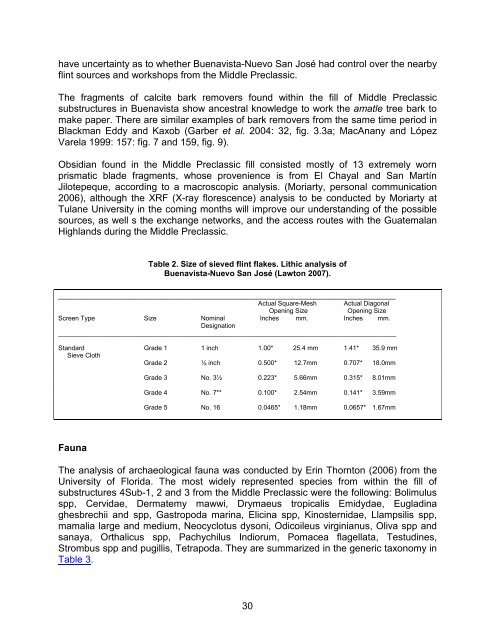Buenavista-Nuevo San José, Petén, Guatemala: Another ... - Famsi
Buenavista-Nuevo San José, Petén, Guatemala: Another ... - Famsi
Buenavista-Nuevo San José, Petén, Guatemala: Another ... - Famsi
Create successful ePaper yourself
Turn your PDF publications into a flip-book with our unique Google optimized e-Paper software.
have uncertainty as to whether <strong>Buenavista</strong>-<strong>Nuevo</strong> <strong>San</strong> <strong>José</strong> had control over the nearby<br />
flint sources and workshops from the Middle Preclassic.<br />
The fragments of calcite bark removers found within the fill of Middle Preclassic<br />
substructures in <strong>Buenavista</strong> show ancestral knowledge to work the amatle tree bark to<br />
make paper. There are similar examples of bark removers from the same time period in<br />
Blackman Eddy and Kaxob (Garber et al. 2004: 32, fig. 3.3a; MacAnany and López<br />
Varela 1999: 157: fig. 7 and 159, fig. 9).<br />
Obsidian found in the Middle Preclassic fill consisted mostly of 13 extremely worn<br />
prismatic blade fragments, whose provenience is from El Chayal and <strong>San</strong> Martín<br />
Jilotepeque, according to a macroscopic analysis. (Moriarty, personal communication<br />
2006), although the XRF (X-ray florescence) analysis to be conducted by Moriarty at<br />
Tulane University in the coming months will improve our understanding of the possible<br />
sources, as well s the exchange networks, and the access routes with the <strong>Guatemala</strong>n<br />
Highlands during the Middle Preclassic.<br />
Table 2. Size of sieved flint flakes. Lithic analysis of<br />
<strong>Buenavista</strong>-<strong>Nuevo</strong> <strong>San</strong> <strong>José</strong> (Lawton 2007).<br />
___________________________________________________________________________<br />
Actual Square-Mesh Actual Diagonal<br />
Opening Size<br />
Opening Size<br />
Screen Type Size Nominal Inches mm. Inches mm.<br />
Designation<br />
______________________________________________________________________________________________<br />
Standard Grade 1 1 inch 1.00* 25.4 mm 1.41* 35.9 mm<br />
Sieve Cloth<br />
Grade 2 ½ inch 0.500* 12.7mm 0.707* 18.0mm<br />
Grade 3 No. 3½ 0.223* 5.66mm 0.315* 8.01mm<br />
Grade 4 No. 7** 0.100* 2.54mm 0.141* 3.59mm<br />
Grade 5 No. 16 0.0465* 1.18mm 0.0657* 1.67mm<br />
Fauna<br />
The analysis of archaeological fauna was conducted by Erin Thornton (2006) from the<br />
University of Florida. The most widely represented species from within the fill of<br />
substructures 4Sub-1, 2 and 3 from the Middle Preclassic were the following: Bolimulus<br />
spp, Cervidae, Dermatemy mawwi, Drymaeus tropicalis Emidydae, Eugladina<br />
ghesbrechii and spp, Gastropoda marina, Elicina spp, Kinosternidae, Llampsilis spp,<br />
mamalia large and medium, Neocyclotus dysoni, Odicoileus virginianus, Oliva spp and<br />
sanaya, Orthalicus spp, Pachychilus Indiorum, Pomacea flagellata, Testudines,<br />
Strombus spp and pugillis, Tetrapoda. They are summarized in the generic taxonomy in<br />
Table 3.<br />
30
















